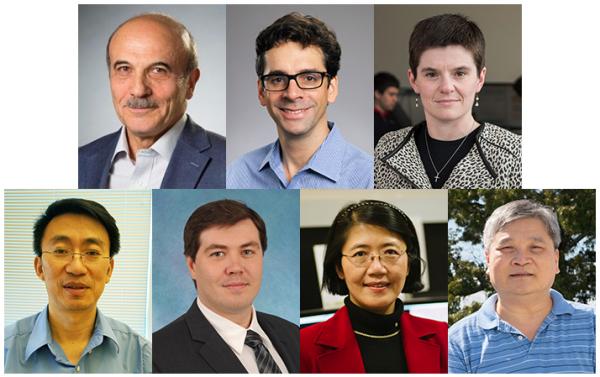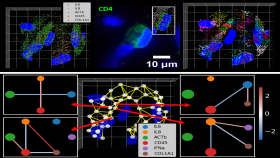The second-annual Machine Learning in Science and Engineering (MLSE) conference being hosted June 10-12, 2019, at Georgia Tech highlights advances in research that utilize methods of artificial intelligence, the development of new machine learning algorithms designed for science and engineering problems, and the ways these methods lead to innovations across various fields. Researchers from academia, government, and industry are gathering to explore the future of research in science and engineering.
The following biomedical engineering faculty from the Wallace H. Coulter Department of Engineering (BME) at Georgia Tech and Emory University are presenting at this year’s MLSE conference:
BME Track Leader:
May D. Wang is a Carol Ann and David D. Flanagan and a Petit Institute Faculty Fellow and full professor in the Coulter Department of Biomedical Engineering. With extensive training and industrial R&D in multimedia computing, she had developed Biomedical and Health Informatics research program with a focus on Biomedical Big Data Analytics for pHealth (Personalized, Preventive, Predictive, Precision Health). Over the past years, she has assisted the biomedical engineering department in growing biomedical computing faculty and in becoming a founding partner in campus-wide machine learning Ph.D. program. She has also helped build and grow a biomedical and health informatics community in both IEEE Engineering in Medicine and Biology Society (EMBS) and ACM Special Interest Group in Biology (SigBIO). During the first two MLSE Annual Conferences (2018 and 2019), Wang was asked by the Georgia Institute of Technology Institute for Data Engineering and Science (IDEaS) to organize and chair a BME Track, with the goal to grow this transdisciplinary area. At MLSE-2019, associate professor Steve Chase from the BME department of Carnegie Mellon University is co-chairing the conference’s BME track. Wang and Chase have invited distinguished colleagues to exchange state-of-art advances in biomedical computation research and education, which cover machine learning (ML) and artificial intelligence (AI) applications in biomechanics, bioinformatics, critical care informatics, neuroinformatics, biomedical imaging informatics, and biochemical engineering. In addition, they will lead a discussion on “Advances of AI and ML in BME: Challenges, Progresses, and Opportunities”, and draft a white paper for wide BME and ML communities.
BME Presentations:
“Scalable Mobile Eye Tracking for Assessing Cognitive Impairment”
Presented by Gari Clifford, associate professor, biomedical engineering and biomedical informatics.
Clifford’s lab works on signal processing, machine learning, and physiological modeling to reduce costs, increase accuracy, and improve access in healthcare using high frequency multivariate data streams.
Clifford’s research interests: Application areas include critical care, sleep and circadian rhythms, perinatal monitoring, and resource-constrained environments such as developing countries.
“SemNet: Semantic inference networks to mine PubMed literature relationships”
Presented by Cassie Mitchell, assistant professor, biomedical engineering.
Mitchell is the principal investigator of the Laboratory for Pathology Dynamics, which uses a combination of big data, machine learning, biostatistics, and informatics-based techniques to identify complex disease etiology, predict new therapeutics, and optimize current interventions. Her lab specializes in integrating and analyzing disparate data sets to obtain actionable insight. Mitchell’s MLSE presentation focuses on using semantic inference networks, natural language processing, and unsupervised machine learning to integrate 28+ million PubMed abstracts into a graphical network where biomedical relationships can be elucidated and ranked with respect to a user-defined target. The lab’s developed literature mining tool, called SemNet, is used to identify and prioritize literature connections for drug targeting, hypothesis assessment, and comparative pathophysiology across multi-scalar biomedical concepts (disease, therapy, genomics, proteomics, etc.). Additional other ongoing projects in the lab are using ML/AI as a feature predictor for enhanced and personalized disease diagnostic, prognostic, and therapeutic decision support for Alzheimer's, ALS, leukemia, and cardiovascular disease.
Mitchell’s research interests: predictive medicine, health informatics, big data, machine learning, personalized medicine, cancer, neuropathology, neuroengineering
“Application of Machine Learning in Cardiovascular Biomechanical Analysis”
Presented by Wei Sun, associate professor, in the Coulter Department of Biomedical Engineering.
Numerical analysis methods, such as structural finite element analysis (FEA), are often used to perform stress analysis of complex structures and systems where it may be difficult to obtain an analytical solution. Recent advances in imaging techniques also make it possible to study the mechanics of human tissues and organs, as well as tissue-medical device interactions at a patient-specific level. However, complexity and time-consuming nature in obtaining patient-anatomic geometries, setting up computational models and high computational cost make it impractical to apply patient-specific computational analyses in time-sensitive clinical applications. To resolve these limitations, we hypothesize that a fully automatic patient-specific modeling workflow could be built upon machine learning (ML) techniques. We have recently developed ML techniques to automate and accelerate the stress analysis process, such as developing deep neural networks (DNNs) as a FEA surrogate for stress analysis. In this presentation, we will illustrate several applications in this effort in the field of cardiovascular biomechanical analysis.
Sun’s research interests: Cardiovascular biomechanics, computational mechanics, and machine learning.
“Application of Machine Learning to Quantification of Complex Cellular Patterns in Imaging Data Using a Set of Metrics from the Shape-to-Graph Mapping”
Presented by Denis Tsygankov, assistant professor, biomedical engineering.
The Integrative Systems Biology Lab, directed by Tsygankov, focuses on integrating experimental and computational methods (involving modeling, simulations, and novel computer vision techniques) to gain a systems-level understanding of complex biological processes. The emphasis is made on biomechanical aspects of physiological phenomena across scales from molecules to cells to tissues.
Tsygankov’s research interests: Cell Biomechanics, Systems Biology, Multiscale Modeling and Simulations, Machine Learning, Vasculogenesis, Cancer Metastasis, Neural Crest Cell in Development, Dendritic Spines in Autism.
“Learning Whole Slide Image Classification via Graph Convolutional Neural Networks”
Presented by May Wang, Carol Ann and David D. Flanagan and a Petit Institute Faculty Fellow and professor, in the Coulter Department of Biomedical Engineering.
Biomedical Whole-Slide Histopathological Imaging has inspired the rapid growth of digital pathology, where big data and AI are enabling better clinical diagnosis and treatment decision making. Ph.D. student Mr. Hang Wu in Professor May Wang’s lab will present how to use deep learning techniques to improve whole slides imaging analysis for both heart transplant rejection patients and breast cancer patients to improve clinical decision precision. The novel pipeline (including a stacked convolutional autoencoder for feature extraction, multiple-instance learning for feature aggregation, feature reduction, and four-hidden-layer perceptron classifier for WSI classification) outperformed both the state-of-art inspired baseline and the pipeline with hand-crafted features. In addition, because out of focus (OOF) area is a common issue in robot-controlled WSI creating, Generative Adversarial Networks (GANs) is attempted to preserve textural details in blind image-to-image translation. By automatically improving image quality, the accuracy of CAD systems has significantly increased. Currently, graph convolutional networks (GCNs) is used to preserve the spatial relationship between tiles in cancerous region.
Poster: “Knowledge Mining”: Wang’s lab has finished prototyping one of the first FHIR (Fast Health Informatics Resource) apps in population health for CDC. In this poster, her students will share how to apply graph embedding on causal chain death prediction using large-volume Italian Ontology data. They use diagnosis codes as nodes and causal relationship between two diagnosis codes as directed edges, and use Attention Walk and SDNE (Structural Deep Network Embedding) to successfully build a graph model that covers all diagnosis codes in our ontology dataset and generate causal chain of death that is both valid to the domain knowledge (causal relationship between two diagnosis codes) and reasonable to physicians.
Poster: “Physiological Informatics”: Wang’s lab also proposed to use deep learning such as convolutional neural network (CNN) and long short-term memory (LSTM) to capture latent dynamics of longer time dependency in ECG signals to predict neonatal infant enteral feeding intolerance (EFI), or possible cardiac arrest. The network is trained end-to-end to minimize the cross-entropy loss for cardiac arrest prediction. In addition, the method to assist interpretation of results (interpretable AI) is researched to assist physician in quickly paying attend to important segments of the time series in clinical decision based on ECG and other vital sign signals. Besides algorithm development, the team has been designing a SMART-on-FHIR application to support EFI surveillance based on real-time monitoring and predictive modeling.
Additional BME faculty presenters include Mark Borodovsky and Cheng Zhu.
Media Contact
Walter Rich
Keywords
Latest BME News
Commercialization program in Coulter BME announces project teams who will receive support to get their research to market.
Courses in the Wallace H. Coulter Department of Biomedical Engineering are being reformatted to incorporate AI and machine learning so students are prepared for a data-driven biotech sector.
Influenced by her mother's journey in engineering, Sriya Surapaneni hopes to inspire other young women in the field.
Coulter BME Professor Earns Tenure, Eyes Future of Innovation in Health and Medicine
The grant will fund the development of cutting-edge technology that could detect colorectal cancer through a simple breath test
The surgical support device landed Coulter BME its 4th consecutive win for the College of Engineering competition.
New research from Georgia Tech helps doctors predict how therapies will interact with a child's immune system, potentially improving outcomes and reducing risks.








